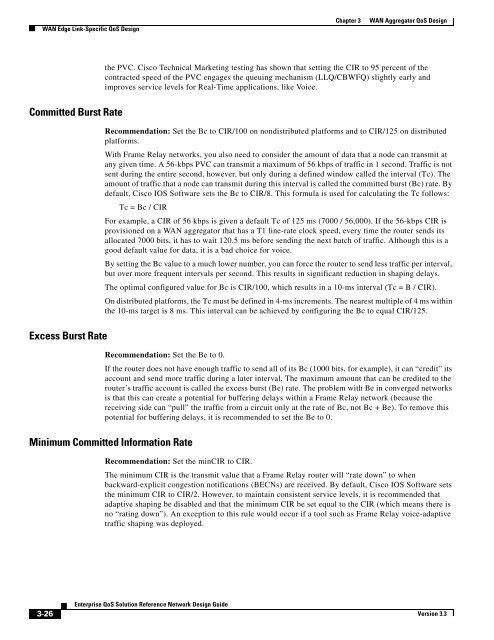Enterprise QoS Solution Reference Network Design Guide
Enterprise QoS Solution Reference Network Design Guide
Enterprise QoS Solution Reference Network Design Guide
You also want an ePaper? Increase the reach of your titles
YUMPU automatically turns print PDFs into web optimized ePapers that Google loves.
WAN Edge Link-Specific <strong>QoS</strong> <strong>Design</strong><br />
Committed Burst Rate<br />
Excess Burst Rate<br />
3-26<br />
<strong>Enterprise</strong> <strong>QoS</strong> <strong>Solution</strong> <strong>Reference</strong> <strong>Network</strong> <strong>Design</strong> <strong>Guide</strong><br />
Chapter 3 WAN Aggregator <strong>QoS</strong> <strong>Design</strong><br />
the PVC. Cisco Technical Marketing testing has shown that setting the CIR to 95 percent of the<br />
contracted speed of the PVC engages the queuing mechanism (LLQ/CBWFQ) slightly early and<br />
improves service levels for Real-Time applications, like Voice.<br />
Recommendation: Set the Bc to CIR/100 on nondistributed platforms and to CIR/125 on distributed<br />
platforms.<br />
With Frame Relay networks, you also need to consider the amount of data that a node can transmit at<br />
any given time. A 56-kbps PVC can transmit a maximum of 56 kbps of traffic in 1 second. Traffic is not<br />
sent during the entire second, however, but only during a defined window called the interval (Tc). The<br />
amount of traffic that a node can transmit during this interval is called the committed burst (Bc) rate. By<br />
default, Cisco IOS Software sets the Bc to CIR/8. This formula is used for calculating the Tc follows:<br />
Tc = Bc / CIR<br />
For example, a CIR of 56 kbps is given a default Tc of 125 ms (7000 / 56,000). If the 56-kbps CIR is<br />
provisioned on a WAN aggregator that has a T1 line-rate clock speed, every time the router sends its<br />
allocated 7000 bits, it has to wait 120.5 ms before sending the next batch of traffic. Although this is a<br />
good default value for data, it is a bad choice for voice.<br />
By setting the Bc value to a much lower number, you can force the router to send less traffic per interval,<br />
but over more frequent intervals per second. This results in significant reduction in shaping delays.<br />
The optimal configured value for Bc is CIR/100, which results in a 10-ms interval (Tc = B / CIR).<br />
On distributed platforms, the Tc must be defined in 4-ms increments. The nearest multiple of 4 ms within<br />
the 10-ms target is 8 ms. This interval can be achieved by configuring the Bc to equal CIR/125.<br />
Recommendation: Set the Be to 0.<br />
If the router does not have enough traffic to send all of its Bc (1000 bits, for example), it can “credit” its<br />
account and send more traffic during a later interval. The maximum amount that can be credited to the<br />
router’s traffic account is called the excess burst (Be) rate. The problem with Be in converged networks<br />
is that this can create a potential for buffering delays within a Frame Relay network (because the<br />
receiving side can “pull” the traffic from a circuit only at the rate of Bc, not Bc + Be). To remove this<br />
potential for buffering delays, it is recommended to set the Be to 0.<br />
Minimum Committed Information Rate<br />
Recommendation: Set the minCIR to CIR.<br />
The minimum CIR is the transmit value that a Frame Relay router will “rate down” to when<br />
backward-explicit congestion notifications (BECNs) are received. By default, Cisco IOS Software sets<br />
the minimum CIR to CIR/2. However, to maintain consistent service levels, it is recommended that<br />
adaptive shaping be disabled and that the minimum CIR be set equal to the CIR (which means there is<br />
no “rating down”). An exception to this rule would occur if a tool such as Frame Relay voice-adaptive<br />
traffic shaping was deployed.<br />
Version 3.3
















